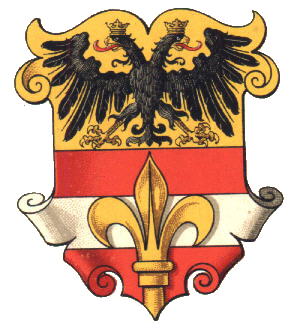Estate of Triest: Difference between revisions
Jump to navigation
Jump to search
Knorrepoes (talk | contribs) m (Text replacement - "====Official blazon====" to "===Official blazon===") |
Knorrepoes (talk | contribs) m (Text replacement - "====Origin/meaning====" to "===Origin/meaning===") |
||
| Line 11: | Line 11: | ||
===Official blazon=== | ===Official blazon=== | ||
===Origin/meaning=== | |||
The Estate and city of Triest (now [[Trieste]], Italy) joined Austria in 1382 as a protection against Venice. The arms were officially granted in 1467 by Emperor Friedrich III after the siege by the Venetians. The arms show in the lower half a spear, symbol of St. Sergius, patron saint of the city on the arms of Austria. The present city uses only the spear in its arms, but in a red field. The upper half shows the Imperial eagle. | The Estate and city of Triest (now [[Trieste]], Italy) joined Austria in 1382 as a protection against Venice. The arms were officially granted in 1467 by Emperor Friedrich III after the siege by the Venetians. The arms show in the lower half a spear, symbol of St. Sergius, patron saint of the city on the arms of Austria. The present city uses only the spear in its arms, but in a red field. The upper half shows the Imperial eagle. | ||
Revision as of 19:44, 22 June 2017
| Heraldry of the World Civic heraldry of the Austro-Hungarian Empire |
ESTATE TRIEST
Official blazon
Origin/meaning
The Estate and city of Triest (now Trieste, Italy) joined Austria in 1382 as a protection against Venice. The arms were officially granted in 1467 by Emperor Friedrich III after the siege by the Venetians. The arms show in the lower half a spear, symbol of St. Sergius, patron saint of the city on the arms of Austria. The present city uses only the spear in its arms, but in a red field. The upper half shows the Imperial eagle.
Contact and Support
Partners:
Your logo here ?
Contact us
© since 1995, Heraldry of the World, Ralf Hartemink 
Index of the site
Literature : Ströhl, 1890










